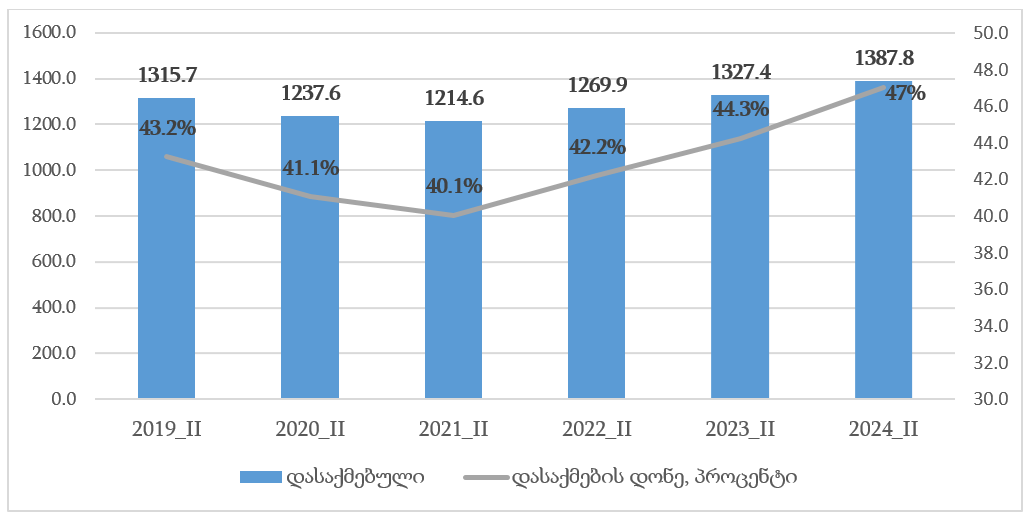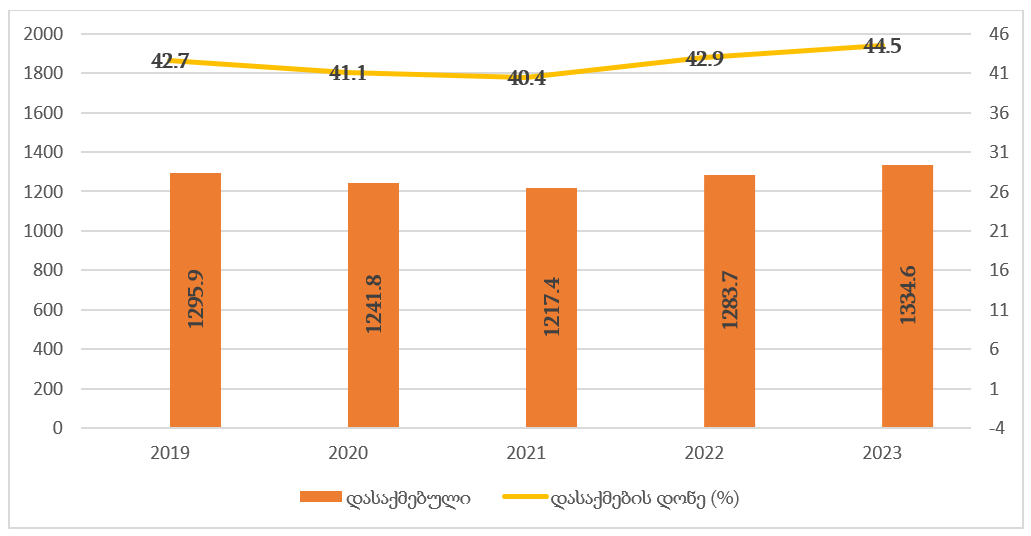Irakli Kobakhidze: “We have created 146,000 new employment opportunities over the past four years.”
Verdict: FactCheck concludes that Irakli Kobakhidze’s statement is HALF TRUE.
The Prime Minister is discussing the number of employed individuals by comparing data from the second quarter of the current year to the annual figures of 2020. This comparison involves the pandemic year, when job losses were particularly severe, leading to a significant drop in the number of employed individuals. Furthermore, quarterly figures should be compared to those of the corresponding quarter to account for the seasonality effect.
The number of employees increased by 72,200 in the second quarter of 2024 as compared to the same period in the pre-pandemic year of 2019. An additional 38,700 individuals gained employment as of 2023 over the past four years.
The number of employees decreased significantly during the pandemic years of 2020 and 2021. However, there has been a positive trend in employment figures since 2022, which can be explained by several factors: the recovery of jobs lost during the pandemic, creation of new employment opportunities, an increase in public sector jobs, including the employment of socially vulnerable individuals in artificially created jobs, etc.
Thus, the Prime Minister cites statistical information in a manipulative form, significantly exaggerating the actual progress. Therefore, FactCheck concludes that Irakli Kobakhidze’s statement is HALF TRUE.
Analysis
When presenting the list of candidate MPs from the Georgian Dream for the 2024 parliamentary elections on 10 September, Prime Minister Irakli Kobakhidze claimed: “We have created 146,000 new employment opportunities over the past four years.”
FactCheck has examined Irakli Kobakhidze’s statement.
The Prime Minister is discussing the number of employed individuals by comparing data from the second quarter of the current year to the annual figures of 2020. This comparison is manipulative and is aimed at exaggerating the reality. Firstly, it is misleading to compare data to 2020, as it was the pandemic year, when job losses were particularly severe, leading to a significant drop in the number of employed individuals. Consequently, the end of the pandemic and the lifting of economic restrictions logically led to the recovery of jobs previously lost.
In addition to the manipulative comparisons with pandemic data, it is also inaccurate to compare quarterly figures to annual ones. Seasonal employment significantly impacts employment rates, so quarterly figures should be compared to those of the corresponding quarter from previous year(s) to account for seasonal effects and allow a more accurate analysis of tendencies as compared to prior periods.
We compared the data from the second quarter of 2024 to the same pre-pandemic period in 2019 for an accurate analysis of employment metrics. According to GeoStat, the number of employees rose by 72,200 during this period, which is half the amount cited by the Prime Minister. The employment rate (the percentage of employed individuals in the population over 15) increased from 43.2% to 47% (refer to Graph 1).
Graph 1: Employed Individuals and Employment Rates in the Second Quarters of 2019-2024

Source: National Statistics Office of Georgia
Furthermore, we examined annual employment rates from 2020 to 2023. Employment metrics in Georgia significantly deteriorated in 2020 and 2021 due to the severe and prolonged economic restrictions during the pandemic. Whilst there was substantial improvement in employment figures in 2022, the pre-pandemic levels had not yet been fully restored. Furthermore, employment improved not only as compared to the previous year but also surpassed the pre-pandemic levels in 2023. An additional 38,700 individuals gained employment as of 2023 over the past four years, from 2019 to 2023.
Graph 2: Employed Individuals and Employment Rates from 2019 to 2023

Source: National Statistics Office of Georgia
It is essential to note the factors that contributed to the rise in employment from 2022 to 2024. First, the end of the pandemic and the lifting of economic restrictions logically led to the recovery of jobs previously lost. Moreover, the employment programme for socially vulnerable citizens contributed to the rise in employment. The aforementioned programme is funded from the state budget and aims to support socially vulnerable employable citizens by primarily creating artificial public sector jobs. Whilst new employment opportunities were also created in the private sector in the same period, they did not grow at the rate portrayed by the Prime Minister.
Thus, making comparisons to the pandemic years, when a significant part of the population was unable to work due to economic restrictions, is manipulative and exaggerates the actual progress in employment figures. Furthermore, comparing quarterly data to annual data is misleading. The real picture is as follows: an additional 38,700 individuals gained employment as of 2023 over the past four years; the number of employees increased by 72,200 in the second quarter of 2024 as compared to the same period in the pre-pandemic year of 2019. Considering the analysis above, FactCheck concludes that the Prime Minister’s statement is HALF TRUE.









